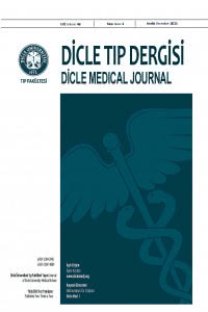Neoadjuvan Kemoterapi Alan Luminal Tip Meme Kanserli Hastalarda Patolojik Tam Yanıtı Predikte Eden Faktörler
Luminal tip meme kanseri, neoadjuvan kemoterapi, patolojik tam yanıt
___
- 1.Siegel RL, Miller KD. Cancer statistics. CA: A Cancer J.Clin. 2020; 70(1): 7–30.
- 2.Cortazar P, Zhang L, Untch M, et al. Pathologicalcomplete response and long-term clinical benefit inbreast cancer: the CTNeoBC pooled analysis. Lancet.2014; 384(9938): 164–72.
- 3.Kim HS, Yoo TK, Park WC, Chae BJ. Potential Benefitsof Neoadjuvant Chemotherapy in Clinically Node-Positive Luminal Subtype Breast Cancer. J BreastCancer. 2019; 22(3): 412–24.
- 4.Goldhirsch A, Wood WC, Coates AS, et al. Strategiesfor subtypes— dealing with the diversity of breastcancer: highlights of the St Gallen International ExpertConsensus on the Primary Therapy of Early BreastCancer 2011. Ann Oncol. 2011; 22(8): 1736–47.
- 5.von Minckwitz G, Untch M, Blohmer JU, et al.Definition and impact of pathologic complete responseon prognosis after neoadjuvant chemotherapy invarious intrinsic breast cancer subtypes. J Clin Oncol.2012; 30: 1796-804.
- 6.Alba E, Calvo L, Albanell J, et al. Chemotherapy (CT)and hormonotherapy (HT) as neoadjuvant treatment in luminal breast cancer patients: results from theGEICAM/2006-03, a multicenter, randomized, phase-IIstudy. Ann Oncol. 2012; 23: 3069-74.
- 7.Schott AF, Hayes DF. Defining the benefits ofneoadjuvant chemotherapy for breast cancer. J ClinOncol. 2012; 30(15): 1747-9.
- 8.National Comprehensive Cancer Network (NCCN).NCCN Clinical Practice Guidelines in Oncology: BreastCancer. Version 3. 2023.
- 9.Kaufmann M, von Minckwitz G, Bear HD, et al.Recommendations from an international expert panelon the use of neoadjuvant (primary) systemictreatment of operable breast cancer: new perspectives2006. Ann Oncol. 2007; 18: 1927–34.
- 10.Mamounas EP. Neoadjuvant chemotherapy inoperable breast cancer. Breast Care. 2006; 1: 348–51.
- 11.Koolen BB, Valde´s Olmos RA, Wesseling J, et al.Early Assessment of Axillary Response with 18F-FDGPET/CT during Neoadjuvant Chemotherapy in Stage II–III Breast Cancer: Implications for SurgicalManagement of the Axilla. Ann Surg Oncol. 2013;20(7): 2227–35.
- 12.Liu C, Jiang Y, Gu X, et al. Predicting level 2 axillarylymph node metastasis in a Chinese breast cancerpopulation post-neoadjuvant chemotherapy:Development and assessment of a new predictivenomogram. Oncotarget. 2017; 8(45): 79147–56.
- 13.Del Prete S, Caraglia M, Luce A, et al. Clinical andpathological factors predictive of response toneoadjuvant chemotherapy in breast cancer: a singlecenter experience. Oncol Lett. 2019; 18(4): 3873–79.
- 14.Reddy Kunnuru SK, Thiyagarajan M, Daniel JM,Balaji Singh K. A Study on Clinical and PathologicalResponses to Neoadjuvant Chemotherapy in BreastCarcinoma. Breast Cancer (Dove Med Press). 2020; 12:259-66.
- 15.Resende U, Cabello C, Ramalho SOB, Zeferino LC.Prognostic assessment of breast carcinoma submittedto neoadjuvant chemotherapy with pathological non-complete response. BMC Cancer. 2019; 19: 601.
- 16.Penault–Llorca F, Cayre A, Bouchet MF, et al.Induction chemotherapy for breast carcinoma:predictive markers and relation with outcome. Int JOncol. 2003; 22: 1319–25.
- 17.Beresford MJ, Stott D, Makris A. Assessment ofclinical response after two cycles of primarychemotherapy in breast cancer. Breast Cancer ResTreat. 2008; 109: 5.
- 18.Petit T,Wilt M, Velten M, et al. Comparative valueof tumour grade, hormonal receptors, Ki-67, HER-2 and topoisomerase II alpha status as predictive markers inbreast cancer patients treated with neoadjuvantanthracycline-based chemotherapy. Eur J Cancer.2004; 40: 205–11.
- 19.Denkert C, Loibl S, Müller BM, et al. Ki-67 levels aspredictive and prognostic parameters inpretherapeutic breast cancer core biopsies: atranslational investigation in the neoadjuvant Gepar-Trio trial. Ann Oncol. 2013; 24(11): 2786–93.
- 20.Kim KI, Lee KH, Kim TR, Chun YS, Lee TH, Park HK.Ki-67 as a predictor of response to neoadjuvantchemotherapy in breast cancer patients. J BreastCancer. 2014; 17: 40-6.
- 21.Caudle AS, Yu TK, Tucker SL, et al. Local-regionalcontrol according to surrogate markers of breastcancer subtypes and response to neoadjuvantchemotherapy in breast cancer patients undergoingbreast conserving therapy. Breast Cancer Res. 2012;14: R83.
- 22.Tan MC, Al Mushawah F, Gao F, et al. Predictors ofcomplete pathological response after neoadjuvantsystemic therapy for breast cancer. Am J Surg. 2009;198: 520-25.
- 23.Phung HT, Nguyen HT, Van Nguyen T, Van NguyenT, Thi Dinh LA, Van Nguyen C. Pathological completeresponse with neoadjuvant trastuzumab combinedwith Chemotherapy in HER2 positive breast cancer: asingle institution retrospective analysis from vietnam.Breast Cancer. 2020; 12: 117–22.
- 24.Swain SM, Ewer MS, Viale G, et al. Pertuzumab,trastuzumab, and standard anthracycline- and taxane-based chemotherapy for the neoadjuvant treatment ofpatients with HER2-positive localized breast cancer(BERENICE): a phase II, open-label, multicenter,multinational cardiac safety study. Ann Oncol. 2018;29(3): 646-53.
- 25.Lee H, Lee DE, Park S, et al. Predicting Response toNeoadjuvant Chemotherapy in Patients With BreastCancer: Combined Statistical Modeling UsingClinicopathological Factors and FDG PET/CT TextureParameters. Clin Nucl Med. 2019; 44(1): 21-9.
- 26.Li Y, Zhang J, Wang B, Zhang H, He J, Wang K. Anomogram based on clinicopathological features andserological indicators predicting breast pathologiccomplete response of neoadjuvant chemotherapy inbreast cancer. Sci Rep. 2021; 11(1): 11348.
- 27.Ferreira R, Kneubil MC, Brollo J, et al. Evaluation ofclinical and pathological response factors toneoadjuvant chemotherapy in breast cancer patients.Mastology. 2021; 31: 1-9.
- 28.Shohdy KS, Almeldin DS, Fekry MA, et al.Pathological responses and survival outcomes inpatients with locally advanced breast cancer afterneoadjuvant chemotherapy: a single-instituteexperience. Journal of the Egyptian National CancerInstitute. 2021; 33(1): 39.
- 29.Fisher B, Bryant J, Wolmark N, et al. Effect ofpreoperative chemotherapy on the outcome ofwomen with operable breast cancer. J Clin Oncol.1998; 16: 2672–85.
- ISSN: 1300-2945
- Yayın Aralığı: 4
- Başlangıç: 1963
- Yayıncı: Cahfer GÜLOĞLU
Cemalettin DURGUN, Ebral YİĞİT
Timucin AKSU, Cigdem TEL USTUNİSİK
Identification of Spore-Forming Intestinal Parasites with Pentaplex Real-Time PCR
Elit Genç Atletlerin Beslenme Durumunun Değerlendirilmesi
Investigation of Hip Extension and Flexion Muscle Strength in Female Weightlifting Athletes
Differentiation of High-Attenuation Renal Cyst and RCC with CT Texture Analysis on Unenhanced CT
Mustafa YILDIRIM, Murat BAYKARA, Mustafa KOÇ
Hacer YERLİKAYA, Filiz ORAK, Murat ARAL, Kezban Tülay YALÇINKAYA, Sezen KOÇARSLAN, Kadir GÜZİN, Adem DOĞANER
Ahmet MURT, Mehmet Riza ALTİPARMAK, Harika Oyku DİNC, Serkan Feyyaz YALİN, Meral MESE, Serap YADİGAR, Zeynep YİLDİZ, Bekir KOCAZEYBEK, Meltem PEKPAK, Muveddet Rezzan ATAMAN
Importance of using tissue PCR to diagnose CMV colitis in ulcerative colitis
Tuba ERÜRKER ÖZTÜRK, Murat KIYICI, Macit GÜLTEN, Enver DOLAR, Selim GÜREL, Selim GİRAY NAK, Fatih EREN
